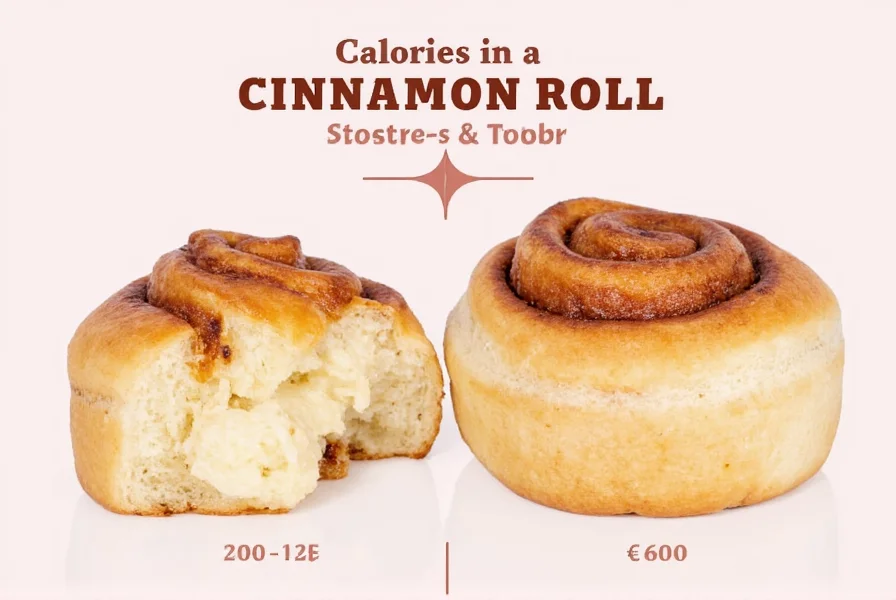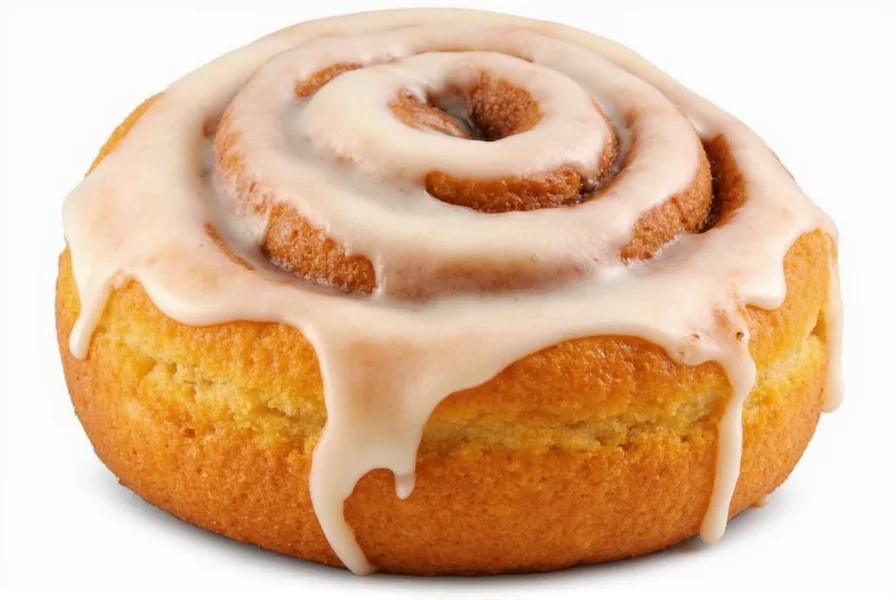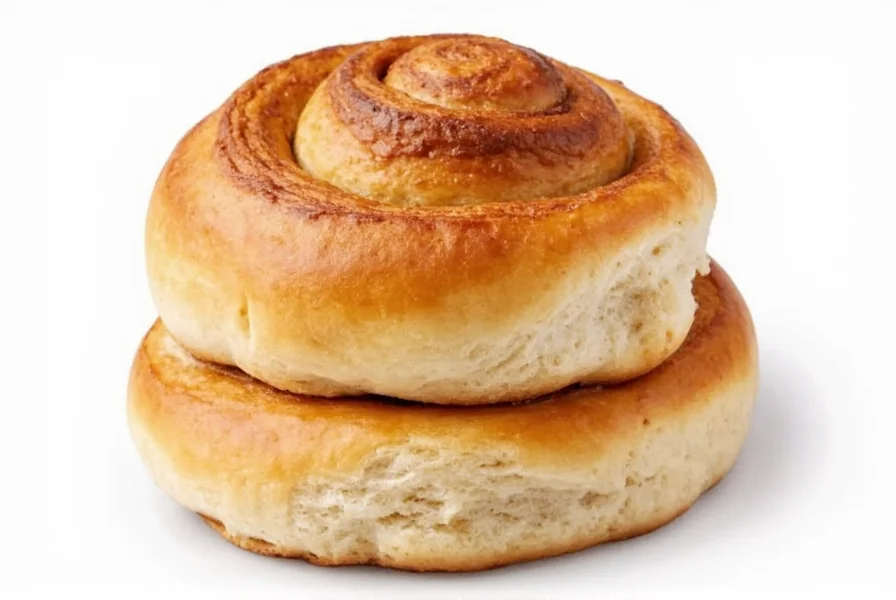Understanding the calorie content in cinnamon rolls is essential for anyone tracking their nutritional intake. Whether you're managing your weight, following a specific diet plan, or simply curious about your favorite pastry's nutritional profile, having accurate information helps make informed dietary choices.
Factors That Affect Cinnamon Roll Calorie Count
Several variables influence the total calories in a cinnamon roll. Recognizing these factors helps explain why calorie counts differ across various sources and recipes.
Size Matters Most
The single biggest factor determining calories in cinnamon roll is portion size. What many consider a "standard" roll varies dramatically:
- Small homemade rolls: 250-350 calories
- Medium bakery rolls: 350-450 calories
- Large gourmet rolls: 500-800+ calories
- Giant "meal replacement" rolls: 800-1,200 calories
Ingredient Variations
Different recipes use varying amounts of key calorie-dense ingredients:
- Butter: Higher butter content increases calories significantly
- Sugar: Both in the dough and the filling affects total count
- Cream cheese frosting: Can add 100-200+ calories per roll
- Flour type: Whole wheat vs. all-purpose makes minor differences
| Type of Cinnamon Roll | Approximate Calories | Typical Serving Size |
|---|---|---|
| Small homemade roll (no icing) | 250-300 | 2.5 oz (70g) |
| Medium bakery roll (with icing) | 350-450 | 3.5 oz (100g) |
| Large chain restaurant roll | 500-650 | 5 oz (140g) |
| Gourmet bakery oversized roll | 700-900 | 7+ oz (200g+) |
| Mini cinnamon roll | 120-180 | 1.5 oz (40g) |
Nutritional Breakdown Beyond Calories
When evaluating calories in cinnamon roll options, consider the complete nutritional profile. A typical medium cinnamon roll (3.5 oz with icing) contains:
- Total Fat: 12-18g (including 6-9g saturated fat)
- Carbohydrates: 50-65g (including 25-35g sugar)
- Protein: 4-6g
- Fiber: 1-2g
The high sugar content relative to other nutrients means cinnamon rolls provide quick energy but minimal sustained fullness. This cinnamon roll nutrition facts profile explains why they're considered an occasional treat rather than a regular breakfast option.
How Cinnamon Rolls Fit Into Daily Calorie Needs
For context, a medium cinnamon roll represents:
- 15-20% of a 2,000-calorie daily diet
- 20-25% of a 1,600-calorie weight loss diet
- Nearly half of many recommended breakfast calorie allowances
When considering calories in homemade cinnamon roll versus store-bought options, homemade versions often allow for ingredient control. You can reduce sugar by 25%, substitute some butter with applesauce, or use whole wheat flour to increase fiber content without dramatically changing the beloved flavor profile.

Smart Strategies for Enjoying Cinnamon Rolls Mindfully
You don't need to eliminate cinnamon rolls entirely from your diet. Consider these practical approaches for enjoying them while managing calorie intake:
Portion Control Techniques
- Split one large roll with a friend
- Choose mini rolls instead of full-sized
- Eat half now and save half for later
- Opt for versions without heavy frosting
Healthier Ingredient Swaps
When making calories in homemade cinnamon roll recipes:
- Replace half the butter with unsweetened applesauce
- Reduce sugar by 25% in both dough and filling
- Use whole wheat pastry flour for added fiber
- Make a lighter glaze with powdered sugar and milk instead of cream cheese frosting
Timing Your Indulgence
Consuming higher-calorie foods like cinnamon rolls earlier in the day gives your body more time to utilize the energy. Pairing your roll with protein (like Greek yogurt) or fiber (like berries) can help moderate blood sugar spikes from the cinnamon roll calories vs other pastries comparison.

Comparing Cinnamon Roll Calories to Other Breakfast Options
Understanding how average calories in a bakery cinnamon roll compare to other common breakfast items provides helpful context:
- Medium cinnamon roll: 350-450 calories
- Bagel with cream cheese: 300-400 calories
- Buttermilk pancakes (2 medium): 400-500 calories
- Oatmeal with fruit (1 cup cooked): 150-200 calories
- Avocado toast (2 slices): 300-350 calories
While cinnamon rolls aren't the highest-calorie breakfast option, they typically contain more sugar and less protein than many alternatives, which affects satiety and energy levels throughout the morning.
Finding Reliable Nutrition Information
When researching calories in cinnamon roll information, verify sources. Restaurant chains typically publish nutrition facts online. For homemade versions, use reputable recipe sites with verified nutrition calculations or calculate using kitchen scales and nutrition databases.
Be cautious of websites making exaggerated health claims about cinnamon rolls. While cinnamon itself has potential health benefits, these don't negate the high sugar and calorie content of traditional cinnamon roll recipes. Focus on low calorie cinnamon roll alternatives if you're seeking healthier options.
Practical Takeaways
Understanding the calorie content in cinnamon rolls empowers you to make informed choices without completely eliminating this beloved treat. By recognizing portion sizes, ingredient variations, and nutritional context, you can enjoy cinnamon rolls as part of a balanced diet.
Remember that occasional indulgence is perfectly compatible with healthy eating patterns. The key is awareness and moderation—knowing exactly what you're consuming allows for better overall dietary planning. Whether you're tracking cinnamon roll nutrition facts for weight management or simply curious about your favorite pastry, having accurate information puts you in control of your dietary choices.
Frequently Asked Questions
How many calories are in a Cinnabon classic roll?
A standard Cinnabon Classic Cinnamon Roll (approximately 5.2 ounces) contains about 880 calories. Their Mini Rolls contain approximately 180 calories each. These values include the signature cream cheese frosting that contributes significantly to the total calorie count.
Are there lower calorie cinnamon roll options available?
Yes, several lower calorie cinnamon roll options exist. Many bakeries offer mini versions (120-180 calories), and homemade recipes can be modified with ingredient substitutions. Some health-focused brands produce reduced-calorie versions using alternative sweeteners and flours, typically ranging from 200-280 calories per roll while maintaining similar portion sizes.
How does the calorie count change if I remove the icing?
Removing the icing typically reduces the calorie count by 80-150 calories, depending on the amount of frosting. For a standard medium cinnamon roll (350-450 calories with icing), going without frosting brings the total to approximately 250-320 calories. The exact reduction depends on how heavily the roll was frosted.
Do homemade cinnamon rolls generally have fewer calories than store-bought?
Homemade cinnamon rolls can have fewer calories than store-bought versions when you control the ingredients, but this isn't automatic. Many traditional homemade recipes are quite rich. However, with modifications like reducing sugar by 25%, using less butter, or making smaller portions, homemade versions typically range from 250-350 calories compared to many store-bought rolls that often contain 400+ calories.
How many calories are in a cinnamon roll from a popular coffee shop chain?
Calorie counts vary by chain. A typical coffee shop cinnamon roll (approximately 4 ounces) contains 380-480 calories. For specific examples: Starbucks Classic Cinnamon Roll has 330 calories (3.3 ounces), while a Panera Cinnamon Crunch Roll contains about 450 calories. Always check current nutrition information as recipes and portion sizes may change.











 浙公网安备
33010002000092号
浙公网安备
33010002000092号 浙B2-20120091-4
浙B2-20120091-4